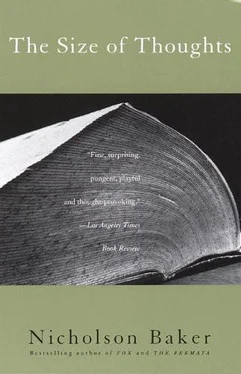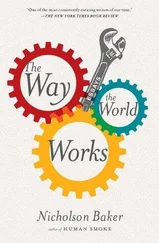Nicholson Baker - The Size of Thoughts - Essays and Other Lumber
Здесь есть возможность читать онлайн «Nicholson Baker - The Size of Thoughts - Essays and Other Lumber» весь текст электронной книги совершенно бесплатно (целиком полную версию без сокращений). В некоторых случаях можно слушать аудио, скачать через торрент в формате fb2 и присутствует краткое содержание. Год выпуска: 1997, Издательство: Vintage, Жанр: Публицистика, Критика, на английском языке. Описание произведения, (предисловие) а так же отзывы посетителей доступны на портале библиотеки ЛибКат.
- Название:The Size of Thoughts: Essays and Other Lumber
- Автор:
- Издательство:Vintage
- Жанр:
- Год:1997
- ISBN:нет данных
- Рейтинг книги:4 / 5. Голосов: 1
-
Избранное:Добавить в избранное
- Отзывы:
-
Ваша оценка:
- 80
- 1
- 2
- 3
- 4
- 5
The Size of Thoughts: Essays and Other Lumber: краткое содержание, описание и аннотация
Предлагаем к чтению аннотацию, описание, краткое содержание или предисловие (зависит от того, что написал сам автор книги «The Size of Thoughts: Essays and Other Lumber»). Если вы не нашли необходимую информацию о книге — напишите в комментариях, мы постараемся отыскать её.
The Size of Thoughts: Essays and Other Lumber — читать онлайн бесплатно полную книгу (весь текст) целиком
Ниже представлен текст книги, разбитый по страницам. Система сохранения места последней прочитанной страницы, позволяет с удобством читать онлайн бесплатно книгу «The Size of Thoughts: Essays and Other Lumber», без необходимости каждый раз заново искать на чём Вы остановились. Поставьте закладку, и сможете в любой момент перейти на страницу, на которой закончили чтение.
Интервал:
Закладка:
Besides platters, the other notable recent development in projectorware is the aforementioned xenon bulb, a two-thousand-watt, foot-long, thousand-dollar item that illuminates a film by sending eighty amperes of direct current through a quartz envelope containing ten atmospheres of excitable xenon. It makes a B-movie sort of zap when it comes on. Through a tiny green portal in the lamphouse, you can peer in on it and watch it radiating away, cooled by indefatigable fans. It, too, caused a flutter of dissent when first introduced: charged xenon was said to produce a noticeably harsher, bluer light than the glowing carbon tips of the arc lamp did. Also, bulbs occasionally “fail violently” (i.e., explode), damaging the focusing mirror in the lamphouse. But the arc lamp gave off toxic fumes, and it was moody: movies were especially luminous on windy days, when the exhaust chimneys drew better and the carbons consequently burned brighter. Objections to xenon have pretty much died down; the only legitimate gripe the moviegoer can make now is that when a bulb fails, even nonviolently (this usually happens after about two thousand hours of service), it takes a while to alert someone in the theater and get the projector stopped, and, since platters can’t be reversed, the audience will miss the stretch of the movie that ran with sound and no picture.
We now know more of the projector’s earliest history, thanks to Christopher Rawlence’s recent book The Missing Reel: The Untold Story of the Lost Inventor of Moving Pictures . It was the movie projector, not the movie camera, that gave early visionaries trouble, since the projector must hold each frame still longer, and must snap to the next frame faster, than a camera does when it exposes film. The original invention, defined as an affair of toothed sprockets that engage with a flexible perforated band carrying sequential images, probably ought to be attributed to Louis Aimé Augustin Le Prince (1841–1890?), a ceramicist and enameler who worked in Leeds. Le Prince filed the relevant patent in 1886 but disappeared several years later, days before he was to leave for the United States with a crated demo model of his epochal “deliverer.” That Thomas Edison’s lawyers had him killed, Rawlence suggests, is unclear.
Edison, tireless and shrewd in his appropriation of other people’s work, unsurprisingly claimed sole authorship of the “Vitascope,” but he and his projector-development team had done little more than slap the Wizard’s name on a machine actually built by Thomas Armat, a Washington inventor, which incorporated principles conceived by Le Prince. Armat’s historic hand was working the crank when, on April 23, 1896, the screen at Koster & Bial’s Music Hall, on West Thirty-fourth Street, wowed journalists with the “Perfect Reproduction of Noted Feminine Figures and Their Every Movement.”
Early projectionists in the wake of Armat were inventors and repairmen, but they were also performers, interpreting the emotional tone of a film by varying the film speed. “The really high-class operator, who produces high-class work on the screen, must and will vary his speed to suit the subject being projected,” F. H. Richardson’s 1912 textbook advised. For example:
[A]s a rule solemn scenes will be improved if the machine turns slowly. Take, for instance … the Pathé Passion Play; probably the Bible patriarchs in real life actually moved as fast as anyone else. They may have, upon occasion, even run. Nevertheless rapid action does not suit our preconceived notions of such things. I have often seen the Pathé Passion Play run at such enormous speed that the characters were jumping around the screen like a lot of school boys. Such an exhibition was disgusting to the audience and offensive to those of deeply religious inclination and who revere those characters.
Even after the electric motor eased the physical labor of the projectionist, silent film studios often furnished cue sheets along with their prints, which itemized the changes in speed that, like tempo markings on a piano score, were an important part of the experience of films such as The Birth of a Nation . One of the reasons silent movies can seem so ridiculous now (in addition to the fact that some of them are ridiculous, of course) is that they are frequently presented at the fixed, twenty-four-frames-per-second rate adopted for equipment in the late 1920s, in conjunction with the optical soundtrack (the ear can’t tolerate changes in speed the way the eye can), rather than at variable rates more in the vicinity of sixteen frames a second, as was conventional until then.
But despite these momentous changes — the stabilization of film speed; sound; Technicolor; the replacement of nitrate-based film with fire-retardant acetate; xenon bulbs; platterization — the really remarkable thing about the evolution of the projector over the past century is how similar in motive essentials a 1994 Simplex machine is to the original Armat/Le Prince design. Film still moves on sprockets with sixteen teeth, and the crucial “intermittent” sprocket — the one that actually stops and starts the film — is still powered, as it was at Koster & Bial’s Music Hall, by a lovely piece of precision machinery called the Geneva movement, which was first developed by Swiss watchmakers to prevent springs from being overwound. The Geneva movement has two main pieces: a Maltese cross (or star, or starwheel) and a more pedestrian cam, both of which splash around half submerged in oil. The pin on the steadily turning cam slips into the slot in the Maltese cross and forces it to rotate a quarter of a turn and then stop dead, immobilized by the cam’s circular edge. When the star is stopped, a single immobile image floods the theater screen for a few hundredths of a second; when it turns, the film advances under cover of shuttered darkness. The moviegoer’s brain, hoodwinked by this succession of still lives, obligingly infers motion.
“You know what a Maltese cross is?” an itinerant projector-repairman with questionable toilet habits asks an incompetent projectionist near the end of Wim Wenders’ mammoth film-fleuve, Kings of the Road . The projectionist takes a guess: Some kind of drink? The repairman shakes his head sadly and tries to explain it to him. “Without this little thing, there’d be no film industry!” he says. The projectionist is unimpressed, and (because Kings of the Road is a semi-comprehensible art movie) he casually inhales the flame from a cigarette lighter to close out the scene. But the workings of the true star system, though they may take a moment to grasp (Fig. 2), repay meditation: seldom has a mechanism so simple, so unexpectedly heraldic, persisted without modification at the center of a ruthless business that has otherwise undergone continuous technical, artistic, and financial upheavals.
The Simplex projector, which many hold to be the finest, is built in Omaha by a company called Ballantyne, which also makes theatrical spotlights and high-tech chicken cookers. The Maltese cross within the Simplex projector, however, is manufactured in Glendale Heights, Illinois, the work of a privately held company called La Vezzi Precision Incorporated, run by fifty-one-year-old Al La Vezzi. Al La Vezzi’s grandfather, Edward La Vezzi, got his start, during the First World War, by milling the worn teeth off projector sprockets and sweating new brass ones on. Now, in a sort of benevolent monopoly, La Vezzi’s company makes sprockets and intermittent movements for Simplex, Century, and Ballantyne projectors (all three brands are co-owned, and based in Omaha), and also for several companies in Europe and Asia, and for Christie projectors made in Cypress, California. For Christie, La Vezzi developed a sealed, belt-driven intermittent movement, called the Ultramittent, that never needs oiling. La Vezzi Precision is also responsible for the legendary VKF sprocket — the Very Kind to Film sprocket, that is — whose teeth are smoothed in meaningful ways by computer-controlled four-axis machining centers. The manufacture of the VKF sprocket is a “no-brainer,” however, according to Mr. La Vezzi, compared to making the Maltese cross, where serious flaws are measured in millionths of an inch. “The slot of a star has to be perfect,” he says, pronouncing “perfect” with inspiring plosiveness.
Читать дальшеИнтервал:
Закладка:
Похожие книги на «The Size of Thoughts: Essays and Other Lumber»
Представляем Вашему вниманию похожие книги на «The Size of Thoughts: Essays and Other Lumber» списком для выбора. Мы отобрали схожую по названию и смыслу литературу в надежде предоставить читателям больше вариантов отыскать новые, интересные, ещё непрочитанные произведения.
Обсуждение, отзывы о книге «The Size of Thoughts: Essays and Other Lumber» и просто собственные мнения читателей. Оставьте ваши комментарии, напишите, что Вы думаете о произведении, его смысле или главных героях. Укажите что конкретно понравилось, а что нет, и почему Вы так считаете.












